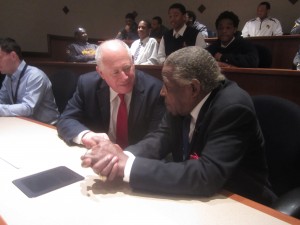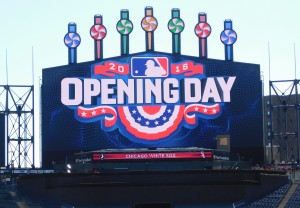Chicago has witnessed many memorable baseball home openers
By George Castle For Chronicle Media — April 11, 2016
VIEW VIDEO: Wrigley Field gets a facelift
The baseball axiom goes “it’s not how you start, it’s how you finish.”
But in the absence of a slew of World Series titles on either side of Chicago, memorable home openers — even ones that go with the often-negative flow of baseball in the city — are the ones that stand the test of time as profound memories.
Many times the game action vied with off-the-field angles that were ridiculous and sublime:
Cubs
April 8, 1969. Cubs 7, Phillies 6 (11 innings). The opener by which all others at Wrigley Field are measured at Wrigley Field. Optimism reigned after two good seasons under Leo Durocher. Ernie Banks, the sunniest Cub, carried that feeling to an SRO throng of more than 40,000 with homers in his first two at-bats. Cubs radio voice Vince Lloyd went deep down to his baritone gut to describe Mr. Cub’s shots on WGN.
But the bedraggled Phils tied the game, then took a 6-5 lead in the 11th. Pinch-hitter Willie Smith, though, brought down the house and drove TV announcer Jack Brickhouse nuts with a one-out, two-run pinch homer in the bottom of the 11th to launch the Cubs on one of the most memorable seasons in their history. For his efforts, Smith was spiked in the mob scene at home plate.
April 6, 1971. Cubs 2, Cardinals 1 (10 innings). The author’s first of 41 consecutive Cubs openers attended. Yet another duel of Hall of Famers Fergie Jenkins of the Cubs and Bob Gibson of the Cardinals. They did not disappoint in 39-degree weather, each pitching into extra innings in a 1-1 tie.
Sure enough, a third future Cooperstown enshrine, Billy Williams, decided it with a one-out homer in the 10th into the right-field bleachers off Gibson. The proud Gibson held his head high as he walked off the mound. Two decades later, he professed to have not remembered the Williams shot. The duel was completed in just one hour, 58 minutes. The great pitchers had nine such matchups between 1967 and 1972 with Jenkins amassing a 5-3 record.

Ron Santo (from left), Vince Lloyd and Ernie Banks were all in the house for memorable Cubs home openers in 1965, 1969 and 1971. (Photo courtesy of George Castle)
April 12, 1965. Cubs 10, Cardinals 10. Another special with the arch-rivals. A back-and-forth game with Roberto Pena, the Cubs’ Dominican shortstop, alternately wearing hero’s and goat’s horns with a homer, double and three errors. Billy Williams played out of position, starting in centerfield.
The Cards led 9-6 with two outs in the ninth when Banks slugged a three-run homer. St. Louis took a 10-9 lead with two outs in the 11th as ex-Cub Lou Brock exacted more revenge with an RBI single. Ron Santo tied the game again in the bottom of the inning on a double. The four-hour, 19-minute game was halted on account of darkness after the 11th. Daylight Savings Time had not taken effect. Such darkness-interrupted games were not suspended and resumed later in 1965. The statistics counted, but the contest had to be replayed in its entirety.
April 5, 1993. Braves 1, Cubs 0. Take that, Stan Cook!
Greg Maddux exacted immediate revenge for Tribune Co.’s bungling of his agreed-to free-agent deal the year before by shutting out the Cubs on five hits over 8 1/3 innings in his first game as a Brave. Maddux outdueled Las Vegas buddy Mike Morgan in two hours, 25 minutes.
Maddux would not return to the Cubs for 11 years, until he was just past his prime. He never wanted to leave in the first place. Meanwhile, Tribune suit Cook got his golden watch and parachute by the end of 1994, the catastrophic damage already done.
April 4, 1994. Mets 12, Cubs 8. The score set the stage for another throwaway Cubs season that ended in August due to the players’ strike. But two individuals on the premises provided interesting storylines.
Cubs leadoff man/center fielder Karl (Tuffy) Rhodes had the game of his life with three solo homers off Mets starter Dwight Gooden in the first, third and fifth innings. For the season, Rhodes slugged a total of eight homers. He’d eventually go to Japan to become a home-run king in their pro leagues.
Meanwhile, First Lady Hillary Clinton was kissed by Harry Caray in the WGN broadcast booth. A few feet away in the press box, approachable one on one even with her Secret Service screening, Clinton said the opener was the first time she had been in Wrigley Field since the 1984 playoffs. So if the potential next president makes a claim as a fan of another team, well, call the FBI! She was a Cubs fan and likely used heavy clout as then-Arkansas First Lady to get into the ’84 playoffs.

Minnie Minoso talks with then-Gov. Pat Quinn at a special event at U.S. Cellular Field in 2014. Minoso had a grand-slam and a walkoff homer in his return to the Sox on Opening Day 1960. (Photo courtesy of George Castle)
White Sox:
April 18, 1972. White Sox 14, Rangers 0. The laugher symbolized the re-energized Sox franchise and rebirth of baseball after its first-ever strike before a roaring after-dark crowd of 20,000.
The shortened season necessitated the first Sox home opener at night as Dick Allen made his Chicago debut with two hits and two RBIs, outfielder Pat Kelly slashed two triples and Wilbur Wood hurled a two-hit shutout. Allen, the best all-around major leaguer in the early 1970s, ended up winning the American League Most Valuable Player award. Caray, then a controversial Sox radio voice, and Allen combined to save the Sox for Chicago after one of the three threatened moves in franchise history.
April 16, 1940. Indians 1, White Sox 0. The crowd of 14,000 was chilled to the bone on a 40-degree windswept Tuesday afternoon. But they were still warmer than the Sox bats.
“Rapid Robert” Bob Feller was at his best. The American League strikeout-whiz kid pitched the first no-hitter ever on Opening Day, walking five and fanning eight. The offensively barren South Side performance was symbolic of the franchise’s Dark Ages that spanned the banning of the Black Sox in 1920 to the beginning of the “Go-Go Sox” era in 1951.
April 19, 1960, White Sox 10, Athletics 9. Minnie Minoso made more noise than the newly christened Bill Veeck exploding scoreboard. Celebrating his return to the Sox after two years in Cleveland, the Cuban Comet slugged a grand-slam homer in the fourth, then won it with a leadoff shot in the bottom of the ninth after the Sox had blown 5-0 and 9-7 leads.
The scoreboard broke down at a crucial moment and the rockets never fired. “This was typical of White Sox luck, even at a high point in their history,” said team historian Rich Lindberg. Attempting to repeat their 1959 pennant, the Sox fell short in the end. Veeck had traded too many promising home-grown players trying to repeat the ’59 triumph. The Sox did not finish first again until the “Winning Ugly” season of 1983.
April 7, 1978, White Sox 6, Red Sox 5. A monster crowd of 50,754 showed up to see if the Sox could resume their “South Side Hit Men” persona of the previous season. Newly acquired Ron Blomberg, the first-ever DH back in 1973 with the Yankees, provided a throwback moment with a game-winning, one-out homer in the bottom of the ninth.
But like the Cubs’ Rhodes in 1994, Blomberg’s blast was his season highlight. In 61 games, he slugged just five homers with a .231 average.
April 5, 1974. Angels 8, White Sox 2. Nolan Ryan bested Wilbur Wood in the forgettable on-field game, played in officially the coldest-ever Opening Day temperatures (37 degrees).
But the action was all off the field. Smack dab in the middle of 1974’s streaker’s craze, undressing in the chill was the style of the afternoon as 30,000 gaped. A naked man jumped onto the field in the left-field corner before he could be covered up, and would suffer frostbite in an embarrassing spot. Assorted women had intentional wardrobe malfunctions throughout the stands. Up in the broadcast booth, Caray had a field day describing the spectacle.
— Chicago has witnessed many memorable baseball home openers —







